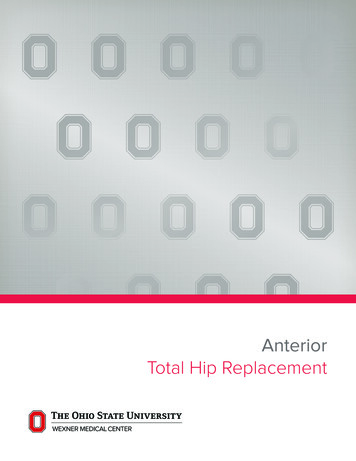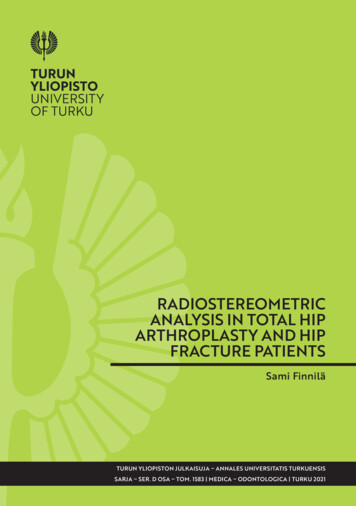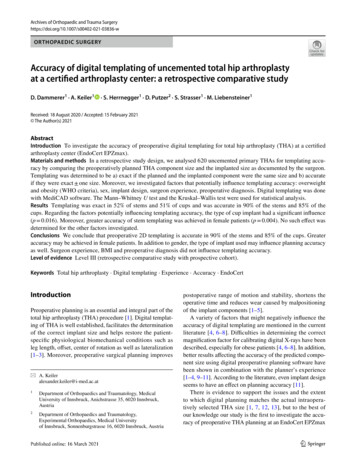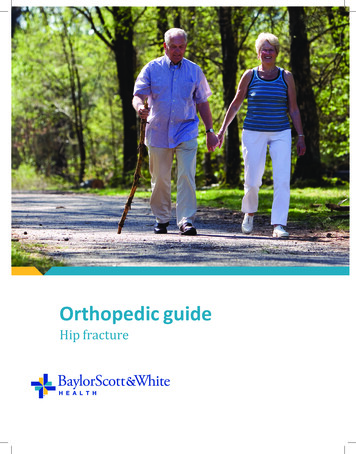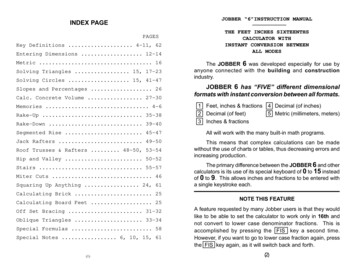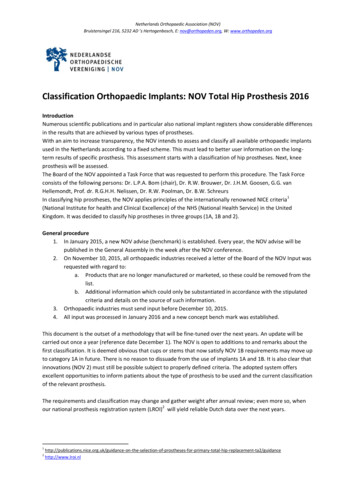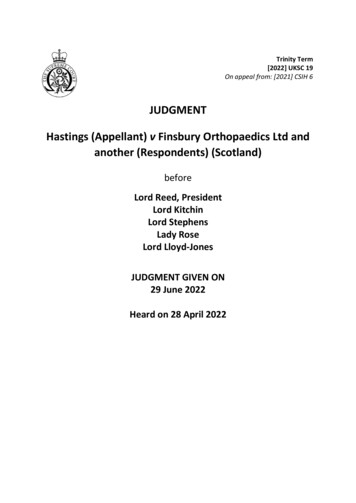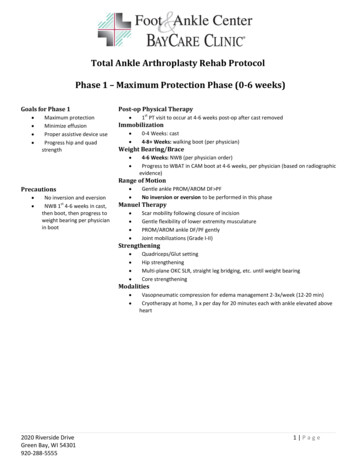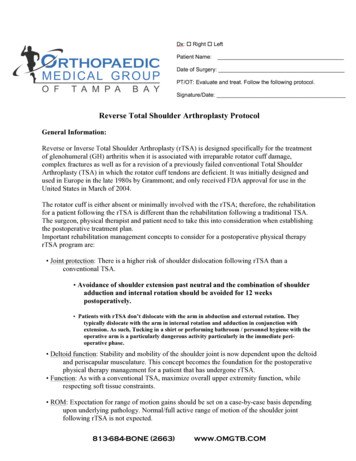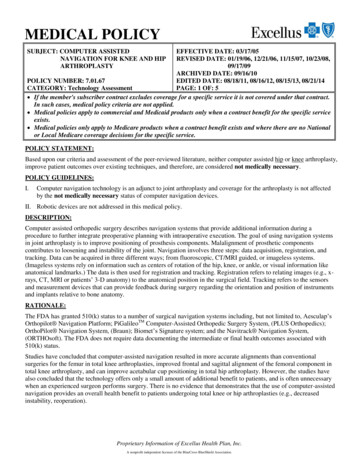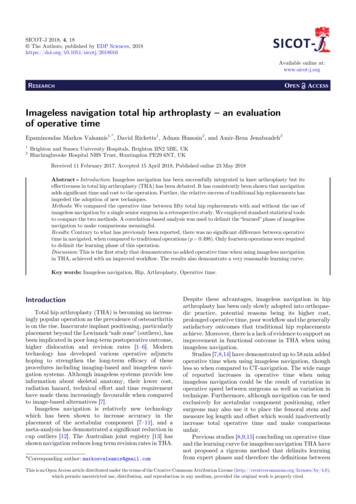
Transcription
SICOT-J 2018, 4, 18 The Authors, published by EDP Sciences, e online at:www.sicot-j.orgRESEARCHImageless navigation total hip arthroplasty – an evaluationof operative timeEpaminondas Markos Valsamis1,*, David Ricketts1, Adnan Hussain2, and Amir-Reza Jenabzadeh212Brighton and Sussex University Hospitals, Brighton BN2 5BE, UKHinchingbrooke Hospital NHS Trust, Huntingdon PE29 6NT, UKReceived 11 February 2017, Accepted 15 April 2018, Published online 23 May 2018Abstract -- Introduction: Imageless navigation has been successfully integrated in knee arthroplasty but itseffectiveness in total hip arthroplasty (THA) has been debated. It has consistently been shown that navigationadds significant time and cost to the operation. Further, the relative success of traditional hip replacements hasimpeded the adoption of new techniques.Methods: We compared the operative time between fifty total hip replacements with and without the use ofimageless navigation by a single senior surgeon in a retrospective study. We employed standard statistical toolsto compare the two methods. A correlation-based analysis was used to delimit the “learned” phase of imagelessnavigation to make comparisons meaningful.Results: Contrary to what has previously been reported, there was no significant difference between operativetime in navigated, when compared to traditional operations (p 0.498). Only fourteen operations were requiredto delimit the learning phase of this operation.Discussion: This is the first study that demonstrates no added operative time when using imageless navigationin THA, achieved with an improved workflow. The results also demonstrate a very reasonable learning curve.Key words: Imageless navigation, Hip, Arthroplasty, Operative time.IntroductionTotal hip arthroplasty (THA) is becoming an increasingly popular operation as the prevalence of osteoarthritisis on the rise. Inaccurate implant positioning, particularlyplacement beyond the Lewinnek “safe zone” (outliers), hasbeen implicated in poor long-term postoperative outcome,higher dislocation and revision rates [1–6]. Moderntechnology has developed various operative adjunctshoping to strengthen the long-term efficacy of theseprocedures including imaging-based and imageless navigation systems. Although imageless systems provide lessinformation about skeletal anatomy, their lower cost,radiation hazard, technical effort and time requirementhave made them increasingly favourable when comparedto image-based alternatives [7].Imageless navigation is relatively new technologywhich has been shown to increase accuracy in theplacement of the acetabular component [7–11], and ameta-analysis has demonstrated a significant reduction incup outliers [12]. The Australian joint registry [13] hasshown navigation reduces long term revision rates in THA.*Corresponding author: markosvalsamis@gmail.comDespite these advantages, imageless navigation in hiparthroplasty has been only slowly adopted into orthopaedic practice, potential reasons being its higher cost,prolonged operative time, poor workflow and the generallysatisfactory outcomes that traditional hip replacementsachieve. Moreover, there is a lack of evidence to support animprovement in functional outcome in THA when usingimageless navigation.Studies [7,8,14] have demonstrated up to 58 min addedoperative time when using imageless navigation, thoughless so when compared to CT-navigation. The wide rangeof reported increases in operative time when usingimageless navigation could be the result of variation inoperative speed between surgeons as well as variation intechnique. Furthermore, although navigation can be usedexclusively for acetabular component positioning, othersurgeons may also use it to place the femoral stem andmeasure leg length and offset which would inadvertentlyincrease total operative time and make comparisonsunfair.Previous studies [8,9,15] concluding on operative timeand the learning curve for imageless navigation THA havenot proposed a rigorous method that delimits learningfrom expert phases and therefore the definitions betweenThis is an Open Access article distributed under the terms of the Creative Commons Attribution License (http://creativecommons.org/licenses/by/4.0),which permits unrestricted use, distribution, and reproduction in any medium, provided the original work is properly cited.
2E.M. Valsamis et al.: SICOT-J 2018, 4, 18Table 1. Patient demographics. Percentages and ranges are shown for categorical and continuous data respectively in brackets.FactorAge (years)GenderMale (%)Female (%)ASABMIAll (n 72)71.4 (54.5–86.3)–24 (36.1)48 (63.9)2 (1.00–4.00)29.9 (19.0–42.0)Traditional (n 36)70.2 (54.5–86.3)–9 (25.0)27 (75)2 (1.00–3.00)30.0 (19.0–42.0)inexperienced and experienced surgeons (in using navigation) are somewhat vague. Indeed, in evaluating andcomparing any new method researchers should carefullyidentify the onset of expert performance in any statisticalanalysis to make comparisons fair. To this end we areutilising a novel two line learning curve model whichallows learning to be delimited from the learned phase.In this study, we compared the operative times in THAwith and without the use of imageless navigation performedby the same surgeon. A key feature of this study is that wedelineated the learning curve for navigation in terms of theoperative time and determined the point at which thesurgeon had, for all intents and purposes, learned theprocedure. This allowed us to restrict the comparison of thetwo methods to the expert stages of the methods making thecomparison valid and meaningful.Materials and methodsAll operations were undertaken by the consultantsurgeon (ARJ) who was proficient in traditional THA andhad already undertaken 130 traditional hip replacementsas a consultant. He had prior experience in the use ofnavigation for total knee replacements.We analysed the surgeon’s first fifty consecutiveimageless navigation-assisted THAs and determined thenumber of operations required to delimit the learningstage; subsequent operations were defined as “learned”.We additionally reviewed the latest consecutive traditional THA operations by the same surgeon and comparedthe operative time to his “learned” navigated operations.All operations studied were primary hip replacements.No revisions were included.Operative records were used to source informationregarding operative time, age, gender, BMI and ASAgrade. We defined operative time as knife-to-skin untilwound closure.Table 1 shows the patient demographics.Surgical techniqueThe patient is placed in the lateral decubitus position.They have a standard posterior support and an anteriorabdominal support placed between the anterior superioriliac spine and the pubic symphysis pubis. This allowspalpation of the bony point to register the Anterior PelvicPlane. The Aesculap Orthopilot THA 1.0 NavigatedNavigated (n 36)72.6 (60.5–85.8)–15 (41.7)21 (58.3)2 (1.00–4.00)29.2 ical technique was used with a mobile tracker fixed tothe iliac crest. Pelvic orientation was defaulted to theAnterior Pelvic Plane, however in high BMI patientswhere the ASIS is not palpable the Acetabular Centre Axiswas utilised. A cup first technique with a posteriorapproach is utilised as per the surgical technique manualfor THA Universal 1.0. The following implants were used:Aesculap plasmafit cup, Excia T stem, polyethylene insertwith either a ceramic or cobalt- chromium head dependingon patient age.Apart from the use of navigation, the surgicalapproach was unchanged between navigated and traditional operations.Statistical analysisAnalysis of the data was undertaken using XLSTATadd-in software [16] on Microsoft Excel as well as SPSSstatistical software [17]. T-tests were used to comparecontinuous, normally distributed data (age, BMI, ASA)whereas chi-squared tests were used to compare categorical data (gender). A p-value less than 0.05 was consideredstatistically significant.Modelling the learning curveRather than attempting to devise a model thatdescribes a general learning scenario, we applied a simplemethod merely to delimit the learning phase from learnedphase in the time series of operative times. This modellingtechnique was developed and adapted by one of theauthors (EMV) [18].Assuming that the first k points in a series of operationsbelong to the learning phase simply represented by astraight line of the form y mx c while the remainingpoints belong to a plateau y j, we aimed to find k thatminimises a simple convex function of the deviations of thecorrelation coefficients of the two phases from their idealvalues and used this as the ordinal value that delimitslearning from learned. This offers a simple and computationally effective method of identifying the ordinal value inthe time series which separates learning from learned.More specifically we considered points (i, xi) i (1–n),where i is the ordinal value in a series and xi is the operativetime of the ith operation. An optimal way of fitting thesedata to a set of two straight lines (a learning line y m.i c and a plateau y j) is to choose p as the value of i that
E.M. Valsamis et al.: SICOT-J 2018, 4, 183Figure 1. Operative time for the first fifty navigated THAs. Double straight line model superimposed.minimises s(p) where:sðpÞ ¼ ½fðpÞ þ 1 2 þ ½gðpÞ 2 :f(p) is the correlation coefficient for the first p datapoints and g(p) the correlation coefficient of the remainingn–p data points.The rationale behind this method is that an ideallearning phase would produce a correlation coefficient of 1 and an ideal plateau would give a correlationcoefficient equal to zero. Any deviation from these idealvalues contributes to an increase in s(p) and by finding thepoint p which minimizes s(p) we conjointly find a “best”compromise between learning and learned.ResultsFigure 2. Comparison of operative time between imagelessnavigation and traditional operations. The means are notsignificantly different, p 0.498.Operative timeFourteen navigated operations were required to reachthe learning plateau for navigated THAs (Figure 1). Wehence compared operative time between the 36 learnednavigated operations and the 36 latest traditionaloperations. There was no significant difference betweenthe operative time for learned navigated (n 36, mean72.6 min) and traditional operations (n 36, mean74.2 min): t-test, p 0.498 (Figure 2).Age, BMI and ASA gradeAge, BMI and ASA grade did not correlate stronglywith operative time, and p values were not significant(Table 2).DiscussionIn this study, we primarily set out to compare theoperative time between navigated and traditional operations. To do this we delimited the learning phase byconsidering the learning curve for navigated THAs by asingle consultant surgeon to allow meaningful comparisonbetween “learned” operations. Our analysis shows thatfourteen operations were required for the surgeon to reacha plateau in terms of operative time (72.6 min).We did not find a significantly different operative timebetween navigated and traditional THAs. Althoughnavigation improved efficiency by avoiding multiplesequential acetabular reamings and repeated trials in
4E.M. Valsamis et al.: SICOT-J 2018, 4, 18Table 2. Univariate statistics. Correlation between age, BMIand ASA grade with operative time. r is the correlationcoefficient.FactorAge with operative timeASA with operative timeBMI with operative timeCorrelationr 0.193, p 0.105r 0.205, p 0.084r 0.080, p 0.506fitting stems to recreate offset and leg length, our resultcontrasts with those of other studies [7–10,14] which havesuggested that navigation adds between 4.5 and 58 min tooperative time. This may be explained by the choice ofnavigation software and workflow, as well as operativetechnique. The presence of a trained operator for thecomputer in all our operations certainly saved time. Oursurgeon’s average operative times (72.6 min navigated,74.2 min traditional) were shorter than those in all theother studies (85–124 min navigated, 77–111 min traditional) [7–10,14] and this may point to the definition ofoperative time as well as variability between surgeons.The need to delimit and hence remove operationsthat belong to the learning phase lead us to establish asimple learning model which offers a simple way to separatelearning from learned. The method uses a dual correlationanalysis that determines the point in the operative series atwhich learned performance has been reached. This can alsobe confirmed on graphical inspection. Of note, our surgeonhad prior experience in navigation, having used it in totalknee arthroplasty. This may mean that his learning phasewas shortened, and as such a greater number of operationsmay be required to achieve learning in a navigation-naïvesurgeon. Nonetheless the purpose of the study was not toinvestigatethelengthoftrainingforthis particularoperationas indeed different surgeons would likely exhibit differentlearning curves. Our results do, however, demonstrate thatthe learning phase for navigated THAs is reasonably short.This study had a few limitations. Firstly, this was aretrospective study, and a well-designed prospectiverandomised control trial will be required to reliablydetermine the difference in operative time, and to comparebetween these two arthroplasty techniques. Second, radiographic analysis of acetabular cup placement such asanteversion and inclination was not possible due to the lackof standardisation in postoperative radiographs. Finally, wedid not investigate functional outcome in this study.ConclusionThe goal of this study was to compare imagelessnavigation THAs with traditional operations. We demonstrated that there was no significant difference in operativetime between these two techniques. This result contradictsprevious research and could be due to optimised workflow,choice of software and theatre personnel familiar withnavigation. This strengthens the argument for imagelessnavigation THA, given its other benefits which includemore accurate cup positioning and reduced revision rates.At the same time a mathematically novel approach tomodelling the learning curve was used to determine thenumber of operations required for a surgeon to master theprocedure. This model has broad application where thelearning phase of a procedure must be delimited.Our study suggests that imageless navigation for THAis a favourable adjunct to modern orthopaedic practiceand the learning curve may not be as protracted as waspreviously thought. Further research is required, particularly in the form of prospective studies, to identify theindividual contribution of specific workflow modificationsin decreasing navigated operative time. More functionaloutcomes of imageless navigation THA patients also needto be studied.Conflicts of interestThe authors declare that they have no conflict ofinterest in relation to this article.References1. D’Lima DD, Urquhart AG, Buehler KO, Walker RH,Colwell CW Jr (2000) The effect of orientation of theacetabular and femoral components on the range of motionof the hip at different head-neck ratios. J Bone Joint Surg A83(3), 315–21.2. Del Schutte H Jr, Lipman AJ, Banner SM, Livermore JT,Ilstrup D, Morrey BF (1998) Effects of acetabular abductionon cup wear rates in total hip arthroplasty. J Arthroplasty13(6), 621–626.3. DeWal H, Su E, DiCesare PE (2003) Instability followingtotal hip arthroplasty. Am J Orthop 32(8), 377–382.4. Paterno SA, Lachiewicz PF, Kelley SS (1997) The influenceof patient-related factors and the position of the acetabularcomponent on the rate of dislocation after total hipreplacement. J Bone Joint Surg Am 79(8), 1202–1210.5. Lewinnek GE, Lewis JL, Tarr R (1978) Dislocations aftertotal hip replacement arthroplasties. J Bone Jt Surg 60A,217.6. Hirakawa K, Mitsugi N, Koshino T, Saito T, Hirasawa Y,Kubo T (2001) Effect of acetabular cup position andorientation in cemented total hip arthroplasty. Clin OrthopRelat Res 388, 135e–142.7. Kalteis T, Handel M, Herold T, Perlick L, Baethis H, GrifkaJ (2005) Greater accuracy in positioning of the acetabularcup by using an image-free navigation system. Int Orthop29(5), 272–276.8. Najarian BC, Kilgore JE, Markel DC (2009) Evaluation ofcomponent positioning in primary total hip arthroplastyusing an imageless navigation device compared withtraditional methods. J Arthroplasty 24, 15–21.9. Thorey F, Klages P, Lerch M, Florkemeier T, Windhagen H,von Lewinski G (2009) Cup positioning in primary total hiparthroplasty using an imageless navigation device: is there alearning curve? Orthopedics 32, 14–17.10. Lass R, Kubista B, Olischar B, Frantal S, Windhager R,Giurea A (2014) Total hip arthroplasty using imagelesscomputer-assisted hip navigation: a prospective randomizedstudy. J Arthroplasty 29(4), 786–791.11. Gandhi R, Marchie A, Farrokhyar F, Mahomed N (2009)Computer navigation in total hip replacement: a metaanalysis. Int Orthop 33(3), 583–587.
E.M. Valsamis et al.: SICOT-J 2018, 4, 1812. Liu Z, Gao Y, Cai L (2015) Imageless navigation versustraditional method in total hip arthroplasty: a metaanalysis. Int J Surg 21, 122–127.13. Donnelly W (2016) Navigation: it’s role in surgery of the hip,Cape Town, South Africa, in Combined Meeting ofOrthopaedic Associations (COMOC).14. Sugano N, Nishii T, Miki H, Yoshikawa H, Sato Y, TamuraS (2007) Mid-term results of cementless total hip replacement using a ceramic-on-ceramic bearing with and withoutcomputer navigation. J Bone Joint Surg Br 89(4), 455–460.15. Kalteis T, Handel M, Balthis H, Perlick L, Tingart M,Grifka J (2006) Imageless navigation for insertion of the5acetabular component in total hip arthroplasty: is it asaccurate as CT-based navigation? J Bone Joint Surg Br88(2), 163–167.16. Addinsoft (2016) XLSTAT 2016, Data analysis andstatistics with Microsoft Excel. Paris, France, Windowsed.17. IBM Corp. Released 2013. IBM SPSS Statistics forWindows, Version 22.0. Armonk, NY: IBM Corp.18. Valsamis EM, Golubic R, Glover TE, Husband H,Hussain A, Jenabzadeh AR (2018) Modeling learning insurgical practice. J Surg Educ 75(1), 78–87.Cite this article as: Valsamis EM, Ricketts D, Hussain A, Jenabzadeh A-R (2018) Imageless navigation total hip arthroplasty –an evaluation of operative time. SICOT-J, 4, 18.
navigation for total knee replacements. We analysed the surgeon's first fifty consecutive imageless navigation-assisted THAs and determined the number of operations required to delimit the learning stage; subsequent operations were defined as "learned". We additionally reviewed the latest consecutive tradi-tional THA operations by the same surgeon and compared the operative time to .
